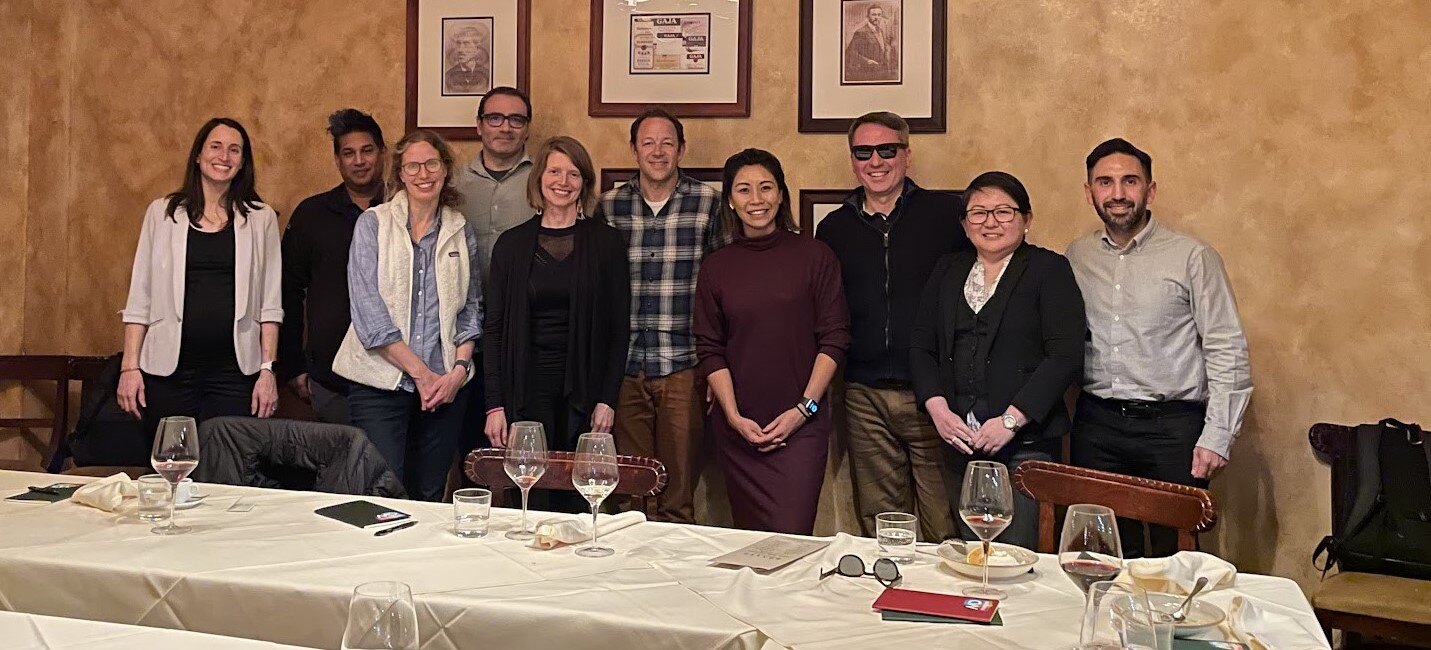
From Left to Right: Dr Jamie Kuhar, Prof. Parag Mallick, Dr Fiona McAllister, Dr Francesco Pingitore, Assist. Prof. Ruth Huttenhain, Dr Josh Elias, Paula Burton, Dr Joey Latham, Dr Lieza Danan, Dr Mark Condina.
Proteomics, the scaled study and characterization of proteins, is critical for comprehending biological processes and disease mechanisms. As the foundation for numerous therapeutic interventions, proteomics is leveraged in the development of treatments targeting proteins implicated in a myriad of conditions, with the majority of FDA-approved drugs targeting proteins.
This field is part of a rapidly expanding market, demonstrating its critical role in advancing medical science and healthcare. Despite this potential, proteomics is hindered by challenges that need to be addressed. Doing so will accelerate research and medical breakthroughs, as well as more effective and efficient therapeutic and clinical strategies.
The "Proteomics Progression: Insights and Inflection Points" symposium brought together 10 key opinion leaders from industry and academic institutions including Eli Lilly (Loxo Oncology), PTC Therapeutics, Chan Zuckerberg Biohub San Francisco, Stanford University, Mass Dynamics, LiVeritas Biosciences and Nautilus Biotechnology. The event was not just a forum for discussion, but also a showcase of the personal and professional journeys of these leaders.
A Humble Beginning:
The evening began with an icebreaker, where leaders shared their first jobs, ranging from candy corn makers to envelope-stuffing to being a lifeguard. This contrast between their humble beginnings and their current roles as pioneers in proteomics added a personal touch that set the stage for open discussions.
The Ten Questions that KOLs asked of each other:
Each leader was invited to bring one pivotal question to the symposium, crafting a comprehensive agenda that spanned the most pressing challenges and opportunities in proteomics.
- What technology can replace Mass Spectrometry for -omics research?
- What do you think has been the biggest recent shift in proteomics?
- How can we be more collaborative to ensure reproducibility and encourage future adjustments?
- Do you keep more [ideas, methods, observations] to yourself/your organization than you really need to? What would it take to share more? Do you think others would benefit if you did?
- In proteomics, we have a lot of existing data. How do we as a community agree on what is the ground truth with respect to protein identification?
- With the increasing wealth of proteomics data, how can we accelerate translating the data into biological and translational language?
- What is the barrier to biologists thinking of proteomics as just a natural and routine part of biological studies?
- Is proteomics ready for the clinic?
- Are HPLCs always the instance that causes the most LC-MS downtime? Which system is the most reliable?
- Proteomics progression on the topic of PTMs characterization, mainly phospho, but it can be any kind of modification also chemically made (i.e. synthesized). I’d like to know more about the confidence of localization, quantification and throughput.
The ten questions above were grouped into broader themes by our masterful facilitator Professor Parag Mallick, which helped guide the discussion within these major areas.
Recent Shifts in Proteomics:
The KOLs have observed a rapid evolution with sample preparation automation, sensitivity and reproducibility improvements of mass spectrometers, and the accelerated application of computational biology strategies. This has broadened the application of proteomics across various research verticals and increased the robustness of data. Moreover, there's an observed rise in data sharing and interoperability, building trust within the community.
Establishing Ground Truth:
The complexity of establishing a 'ground truth' in proteomics was extensively debated. The discussion focused on the standardization of the way mass spectrometry data is analyzed and interpreted, and the lack of standardized repositories for certain types of data. This highlights the need for a more global approach to validation.
Integrating Proteomics into Biological Studies:
A significant barrier discussed was the integration of proteomics into routine biological studies. Participants emphasized the need for "glue people" — communicators and advocates who can bridge gaps between various stakeholders. The discussion also highlighted the importance of making proteomic data more accessible and understandable to non-experts, potentially transforming proteomics into a commonplace tool in biological research, similar to how genomics has been integrated.
Technological Alternatives to Mass Spectrometry:
The discussion on potential replacements for mass spectrometry in the coming years revealed a mix of skepticism and optimism. While mass spectrometry is expected to remain a critical analytical approach, technologies such as affinity-based methods, micro-arrays, and protein sequencing are developing rapidly. The affordability and technological improvements in these areas suggest they might substitute or, in some cases, complement mass spectrometry, particularly in non-human research and clinical applications.
Openness in Sharing:
The need for greater transparency to enhance reproducibility and collaboration was strongly voiced. The community is pushing for clear standards and validation criteria to avoid misinterpretations and ensure the accuracy of proteomic analyses.
Clinical Readiness of Proteomics:
The question of whether proteomics is ready for clinical applications sparked a vibrant debate. Discussions ranged from the use of tools like the Mass Spec pen in clinical settings to the broader implications of applying proteomic analyses for single proteins versus comprehensive protein profiling. Although there was no consensus, the debate underscored the ongoing exploration and potential of proteomics in clinical contexts.
Conclusion and where to now?
As the evening concluded, it was evident that while proteomics faces substantial challenges, it is also on the brink of transformative breakthroughs. The robust discussions showcased a community ready to collaborate and innovate and highlighted the need for these conversations to continue and expand.
Where to now? Recognizing the importance of cross-disciplinary engagement, there was significant enthusiasm among attendees for organizing the next dinner to include topics around broader omics fields, ensuring the inclusion of experts from genomics, transcriptomics, metabolomics, and other related areas - as well as clinicians.
Mass Dynamics’ involvement
Mass Dynamics commits to supporting these ongoing discussions and facilitating the sharing of knowledge across the community. By driving these gatherings and encouraging open dialogue, we aim to foster a collaborative environment that addresses the current questions facing proteomics and anticipates future challenges and opportunities. We aim to propel the field forward and ensure that the insights gained from these discussions are disseminated widely, enhancing the collective understanding and application of proteomics in both research and clinical settings.
The anticipation for future gatherings clearly indicates the value such forums provide in driving innovation, and fostering a holistic view of omics science. If you are interested in attending or contributing to this future event and discussion, please contact community@massdynamics.com
Disclaimer:
This blog post was produced by Paula Burton using a combination of original notes from the discussion, insights collected from attendees during the event (including Assistant Prof. Ruth Huttenhain, Dr. Francesco Pingitore, Dr. Jamie Kuhar, Prof. Parag Mallick, Assoc. Prof. Josh Elias, Dr. Mark Condina, Dr. Fiona McAllister, Dr Lieza Danan and Dr Joey Latham), and final compilation was completed with assistance from ChatGPT. The final blog post was reviewed by some attendees. Any errors or omissions are unintentional and the content is provided for informational purposes only.
